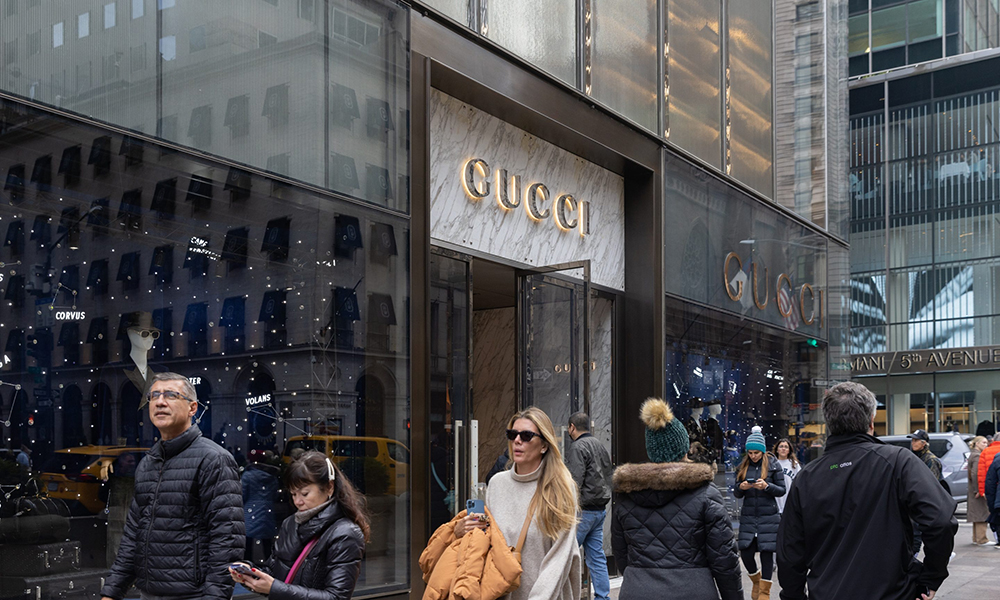
前几个奢侈品行业的惨淡行情让不少人质疑美国“繁荣的20年代”是否已经结束了。但实际上,前几年奢侈品行业的异常繁荣,很大程度上是因为疫情期间,人们出不了门,消费欲无处发泄,便疯狂网购昂贵的衣服、鞋包等等,从而导致了奢侈品销量的飙升。现在,各大奢侈品品牌都面临着销量下滑的局面,但也有几个品牌却准备在世界顶级的购物中心里扩大自己的零售面积。
比如,法国开云集团在本周一表示,将投资9.63亿美元于纽约市的高端地产。开云集团旗下拥有古驰(Gucci)、圣罗兰(Saint Laurent)和巴黎世家(Balenciaga)等知名奢侈品品牌。
开云集团在声明中称:“通过这笔交易,开云集团在世界上最具标志性的街道上获得了绝佳的零售地点。这笔投资代表着开云集团的精选地产战略迈出了新的一步,我们的目标就是确保零售店的绝佳地段。”
这处地产占地约10700平方米,坐落于曼哈顿著名的第五大道,对面就是特朗普大厦,附近还有卡地亚(Cartier)、路易威登(Louis Vuitton)和蒂芙尼(Tiffany & Co)等高端奢侈品品牌的门店。
近年来,开云集团还在巴黎和东京等地买下了几处黄金地段。
无独有偶
除了开云集团,其他一些奢侈品品牌也正在全美各大城市抢占零售地产。比如历峰集团旗下的珠宝品牌梵克雅宝表示,将在曼哈顿的麦迪逊大道开设新门店。而香奈儿(Chanel)在洛杉矶比佛利山的旗舰店也将重新开张。另据彭博社报道,普拉达(Prada)上个月也进行了两笔总价值8.35亿美元的地产投资。
开云集团拒绝就这笔房地产收购交易发表评论。
实际上,各大奢侈品零售商都在以惊人的速度抢购地产。据房地产投资公司JJL的一份报告显示,从2022年9月到2023年9月,各大奢侈品品牌在美国一共租赁了65万平方英尺的零售面积,较上年同期增长了大约160%。
这些品牌也并不是在盲目地进行地产投资。毕竟随着疫情过去,人们会逐步回到实体店,来解决网购以外的消费需求。穆迪公司的一位高级经济学家本月初向《财富》表示,尽管其他行业仍在复苏路上,但是美国的商业地产2024年肯定会保持“稳健”。
收入下滑
就在这些奢侈品公司大肆在地产市场上“买买买”之际,奢侈品的消费者们却已经收紧了荷包,导致不少奢侈品牌的销量都受到了影响。比如开云集团第三季度的可比营收下降了9%,特别是古驰和伊夫圣罗兰这两个品牌的销量下跌明显。
可以肯定的是,美国市场一直是部分奢侈品品牌的亮点,而欧洲市场却已经难以复刻早些年的繁荣时光。以历峰集团为例,其美洲市场(包括北美和南美)2023年第三季度的销售额同比增长了8%。而与之形成鲜明对比的是,同一时期欧洲市场的销量则下滑了3%。
不过这种趋势也并非普遍现象。比如路威酩轩集团旗下的化妆品连锁零售品牌丝芙兰(Sephora)今年第三季度在北美市场呈现强势增长。但与此同时,该集团旗下的葡萄酒、洋酒、皮具和时尚产品等则显得相对疲软。纵向相比,英国的风衣品牌巴宝莉(Burberry)第三季度在美洲的同店销售额降幅最大。
从这些或好或坏的迹象看,它们总的来说预示着市场增长放缓,而另一方面也预示着中国的奢侈品需求或将复苏,而这可能会对奢侈品的销量产生刺激作用。奢侈品行业领头羊路威酩轩集团将于本周四发布财报,这份财报或将暗示2024年整个行业的行情走向。(财富中文网)
译者:朴成奎
前几个奢侈品行业的惨淡行情让不少人质疑美国“繁荣的20年代”是否已经结束了。但实际上,前几年奢侈品行业的异常繁荣,很大程度上是因为疫情期间,人们出不了门,消费欲无处发泄,便疯狂网购昂贵的衣服、鞋包等等,从而导致了奢侈品销量的飙升。现在,各大奢侈品品牌都面临着销量下滑的局面,但也有几个品牌却准备在世界顶级的购物中心里扩大自己的零售面积。
比如,法国开云集团在本周一表示,将投资9.63亿美元于纽约市的高端地产。开云集团旗下拥有古驰(Gucci)、圣罗兰(Saint Laurent)和巴黎世家(Balenciaga)等知名奢侈品品牌。
开云集团在声明中称:“通过这笔交易,开云集团在世界上最具标志性的街道上获得了绝佳的零售地点。这笔投资代表着开云集团的精选地产战略迈出了新的一步,我们的目标就是确保零售店的绝佳地段。”
这处地产占地约10700平方米,坐落于曼哈顿著名的第五大道,对面就是特朗普大厦,附近还有卡地亚(Cartier)、路易威登(Louis Vuitton)和蒂芙尼(Tiffany & Co)等高端奢侈品品牌的门店。
近年来,开云集团还在巴黎和东京等地买下了几处黄金地段。
无独有偶
除了开云集团,其他一些奢侈品品牌也正在全美各大城市抢占零售地产。比如历峰集团旗下的珠宝品牌梵克雅宝表示,将在曼哈顿的麦迪逊大道开设新门店。而香奈儿(Chanel)在洛杉矶比佛利山的旗舰店也将重新开张。另据彭博社报道,普拉达(Prada)上个月也进行了两笔总价值8.35亿美元的地产投资。
开云集团拒绝就这笔房地产收购交易发表评论。
实际上,各大奢侈品零售商都在以惊人的速度抢购地产。据房地产投资公司JJL的一份报告显示,从2022年9月到2023年9月,各大奢侈品品牌在美国一共租赁了65万平方英尺的零售面积,较上年同期增长了大约160%。
这些品牌也并不是在盲目地进行地产投资。毕竟随着疫情过去,人们会逐步回到实体店,来解决网购以外的消费需求。穆迪公司的一位高级经济学家本月初向《财富》表示,尽管其他行业仍在复苏路上,但是美国的商业地产2024年肯定会保持“稳健”。
收入下滑
就在这些奢侈品公司大肆在地产市场上“买买买”之际,奢侈品的消费者们却已经收紧了荷包,导致不少奢侈品牌的销量都受到了影响。比如开云集团第三季度的可比营收下降了9%,特别是古驰和伊夫圣罗兰这两个品牌的销量下跌明显。
可以肯定的是,美国市场一直是部分奢侈品品牌的亮点,而欧洲市场却已经难以复刻早些年的繁荣时光。以历峰集团为例,其美洲市场(包括北美和南美)2023年第三季度的销售额同比增长了8%。而与之形成鲜明对比的是,同一时期欧洲市场的销量则下滑了3%。
不过这种趋势也并非普遍现象。比如路威酩轩集团旗下的化妆品连锁零售品牌丝芙兰(Sephora)今年第三季度在北美市场呈现强势增长。但与此同时,该集团旗下的葡萄酒、洋酒、皮具和时尚产品等则显得相对疲软。纵向相比,英国的风衣品牌巴宝莉(Burberry)第三季度在美洲的同店销售额降幅最大。
从这些或好或坏的迹象看,它们总的来说预示着市场增长放缓,而另一方面也预示着中国的奢侈品需求或将复苏,而这可能会对奢侈品的销量产生刺激作用。奢侈品行业领头羊路威酩轩集团将于本周四发布财报,这份财报或将暗示2024年整个行业的行情走向。(财富中文网)
译者:朴成奎
The luxury industry’s rocky road over the past few months has prompted questions about the end of the “roaring 20s”—the period during the COVID-19 pandemic when sales skyrocketed, thanks to homebound shoppers splurging on expensive clothes, handbags, and more. But some while luxury brands navigate a slowdown, others are simultaneously gearing up to grow their retail space in the world’s top shopping hubs.
French group Kering, the brand behind luxury houses like Gucci, Saint Laurent and Balenciaga, is investing a whopping $963 million in prime New York City property, the company said in a press release Monday.
“With this transaction, Kering acquires exceptional retail locations on one of the world’s most iconic avenues,” Kering said in the statement. “This investment represents a further step in Kering’s selective real estate strategy, aimed at securing key highly desirable locations for its Houses.”
The property will span 115,000 square feet (10,700 square meters), and will be located on Manhattan’s famed Fifth Avenue, across from Trump Tower. Some of the other high-end retailers located in the vicinity include Cartier, Louis Vuitton, and Tiffany & Co.
The François-Henri Pinault–led company has also purchased other key properties in Paris and Tokyo in recent years.
Kering not alone
Kering is joining some of its luxury rivals in grabbing retail property in New York and elsewhere in the U.S.—jeweler Van Cleef & Arpels (owned by Richemont) said it was opening new locations on Manhattan’s Madison Avenue, while Chanel reopened its flagship store in the upmarket Los Angeles area of Beverly Hills. And Prada made two purchases worth $835 million combined last month, Bloomberg reported.
Kering declined to comment on the new real estate acquisition.
Indeed, luxury retailers are snapping up property at stunning rates—they’ve leased 650,000 square feet of space in the U.S. in the 12 months to September, marking a roughly 160% increase compared with a year earlier, according to a report by real estate investment firm JLL.
The bet on retail real estate could potentially pay off as people come back to physical stores to supplement their shopping needs alongside buying online. Retail properties promise to be a “stalwart” through 2024, a senior Moody’s economist told Fortune earlier this month, even as other sectors continue to recover.
Revenue slump
These big purchases by luxury players come at a time when the industry is seeing its wealthy customers pull back on spending, the impact of which has trickled down to the sales of these brands. Kering’s revenue was down 9% on a comparable basis for the third quarter, with contractions in Gucci and Yves Saint Laurent sales.
To be sure, the U.S. has been a bright spot for some brands, as Europe struggles to clock in sales like it did in earlier years. Take Richemont, for instance—sales in the Americas region (which includes North and South America) saw 8% growth in the third quarter of 2023, compared with the same time a year earlier. That’s in contrast with a 3% decline in Europe for that period.
The trend isn’t universal, though. Makeup chain Sephora, owned by LVMH, saw strong growth in North America in the third quarter, although demand for the French conglomerate’s wine and spirits as well as fashion and leather goods segments remained weak through the first half of last year. British trench-coat maker Burberry also saw comparable store sales in its third quarter decline the most in the Americas compared with the same time in 2022.
The signs are mixed in the luxury space as they point to a slowing pace of growth while also hinting at a revival of Chinese luxury demand—which could fuel sales. Luxury bellwether LVMH is set to release results Thursday, which could indicate the path forward for the rest of the industry as 2024 unfolds.






